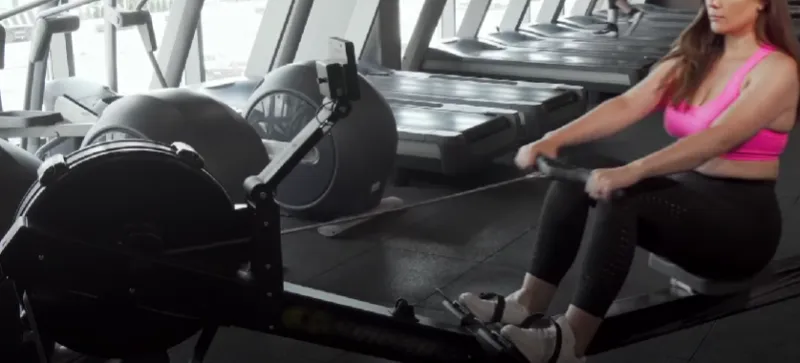Rowing provides a full-body workout, strengthening muscles in the arms, legs, and core and increasing cardiovascular endurance. Cycling enhances aerobic capacity, improving cardiovascular health and lung efficiency.
Both rowing and cycling offer excellent cardiovascular workouts, but your choice depends on your fitness goals. The rower gets a full-body workout, engaging more muscle groups, which can lead to greater overall strength and endurance. Cycling is easier on the joints and longer durations are more accessible.
In this blog post, we’ll discuss the critical differences between rowing and cycling so you can determine which is best for your fitness goals.
Is Rowing Better Than Cycling: 5 Comparison

Rowing and cycling activities offer fantastic cardiovascular benefits and can help you stay in shape. However, delving deeper into the intricacies of each sport reveals unique advantages that make rowing stand out. In this article, we’ll compare rowing and cycling across five key aspects to explain why rowing might be the superior choice for your fitness journey.
Muscle Comparison of Rowing and Cycling
Both exercises offer unique benefits that target different muscle groups to compare muscle engagement between rowing and cycling. Let’s explore how rowing and cycling impact muscle development:
Rowing
Rowing predominantly targets the muscles of the back, arms, shoulders, and legs. This full-body workout strengthens and tones these muscle groups, improving flexibility and coordination. The pulling motion in rowing engages the back muscles, biceps, and core, while the leg drive works the quadriceps, hamstrings, and glutes. Continuous fluid movement in rowing helps develop muscular endurance and power.
Cycling
Cycling primarily focuses on the muscles in the lower body, mainly the glutes, quadriceps, and hamstrings. The pedaling action builds strength in these muscle groups, improving leg power and endurance. Additionally, cycling can help tone the core muscles, especially when maintaining proper posture throughout the ride. Indoor cycling classes incorporating intervals or sprints can further engage muscles and boost overall fitness levels.
Comparison of Cardiovascular Benefits
A comparison of rowing versus cycling reveals that both activities enhance heart health by elevating heart rate and improving circulation. Comparing rowing and cycling for cardiovascular fitness, here are some differences:
Rowing
Rowing emerges as a stellar contender for cardiovascular health because of its holistic full-body engagement. This activity involves upper and lower body muscles, effectively increasing heart rate and promoting efficient circulation. The synchronized movement in rowing boosts cardiovascular endurance and strengthens the heart muscles.
The comprehensive nature of rowing makes it a compelling choice for individuals seeking a well-rounded cardiovascular workout that targets multiple muscle groups simultaneously.
Cycling
Conversely, cycling primarily emphasizes lower body strength and endurance while delivering an exceptional cardiovascular workout. The consistent pedaling action in cycling engages the quadriceps, hamstrings, calves, and glutes, providing a rigorous exercise that elevates the heart rate and builds cardiovascular fitness.
By focusing on lower body muscle engagement and endurance, cycling is renowned for enhancing aerobic capacity and lowering blood pressure. It also reduces the risk of heart disease and blood pressure.
Comparison of Calories Burned in Rowing vs. Cycling
Rowing and cycling are the two most popular exercises to help you burn calories effectively. These two activities provide excellent cardiovascular workouts while engaging different muscle groups. Here’s a comparison of the calories burned during rowing and cycling:
Rowing
Workouts involving the arms, legs, back, and core are often touted for their ability to torch calories efficiently. If somebody weighs 155 pounds, they will burn approximately 260 calories in 30 minutes of moderate rowing at a vigorous pace. Rowing’s continuous motion elevates heart rate and offers a low-affected way to strengthen various muscle groups simultaneously.
cycling
Cycling provides a high-intensity cardio workout that can lead to significant calorie expenditure, whether indoors on a stationary bike or outdoors. A person of similar weight can burn roughly 210-310 calories in a half-hour cycling session at a moderate to intense pace. Exercise that targets the legs primarily targets the quadriceps, hamstrings, and calves but also engages the core.
Cycling Vs Rowing: Comparisons of Accessibility And Convenience

Several key factors can influence your decision-making when comparing the accessibility and convenience of cycling versus rowing for your fitness routine.
Rowing
Whether done on water or using an indoor rowing machine, it offers a unique full-body workout but may require access to specific equipment and facilities. Water rowing provides a serene experience but depends on proximity to suitable bodies of water. Indoor rowing machines, while compact and space-efficient, deliver a challenging workout without outdoor access. They can be used conveniently at home or in a gym, providing a low-impact, effective exercise option.
Cycling
Cycling stands out for its widespread accessibility, catering to people of various fitness levels and age groups. Whether you prefer outdoor cycling on scenic trails or indoor stationary biking at a gym or home, the flexibility of cycling makes it a convenient option. Outdoor cycling offers the freedom to explore different terrains and can easily be integrated into daily activities like commuting or running errands. Indoor cycling provides a weather-independent alternative that is especially beneficial during unfavorable weather conditions or tight schedules.
Comparison Of Cycling And Rowing: Injury Risks
When comparing the injury risk and safety considerations between cycling and rowing as exercise activities, several factors come into play that can influence the likelihood of injuries and the overall safety of each workout.
Rowing
It is considered a low-impact exercise with minimal joint impact, which makes it a good choice for people of all fitness levels. However, improper rowing technique or excessive intensity without proper form can lead to injuries, especially in the shoulders, lower back, and wrists. Rowers must receive instruction on proper form and technique to reduce the risk of strain or injury. Additionally, rowing on water presents additional safety considerations such as water conditions, boat traffic, and weather awareness.
Cycling
It carries a relatively low risk of affected-related injuries indoors or outdoors compared to high-affected activities like running. However, cyclists may still be susceptible to overuse injuries, particularly in the knees, lower back, and hips, because of the repetitive nature of pedaling motion. Proper bike fit, correct posture, and gradual training progression can help mitigate the risk of these overuse injuries. Additionally, outdoor cyclists need to be mindful of road hazards, traffic conditions, and unpredictable weather that can impact safety during rides.
Conclusion
Rowing and cycling both offer unique health and fitness benefits. Rowing offers a full-body workout, higher calorie burn, and is gentle on the joints. Cycling focuses on lower-body strength and cardiovascular endurance and offers the flexibility of indoor and outdoor exercise.
Ultimately, choosing rowing or cycling depends on your preferences and fitness goals. Both activities improve cardiovascular health, build strength, and promote overall fitness. Consider what you enjoy most and what aligns with your goals to make the best choice for your routine.
FAQs
Can I Do Both Rowing And Cycling As Part Of My Fitness Routine?
Yes, of course! A combination of rowing and cycling can offer a balanced workout, targeting various muscle groups and preventing monotony during exercise.


